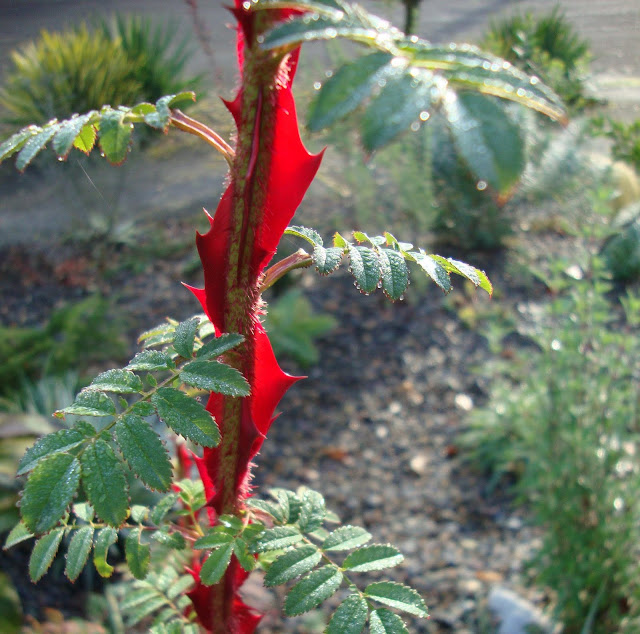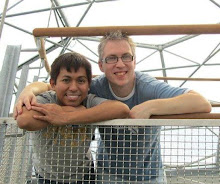It was a frosty and a little bit snowy start to the weekend that's just gone past, with thick frost covering the roofs, ground, and plants greeting us as we went out into the garden last Saturday morning. There was a bit of snow the day before too, although most of it has melted by the evening, a little bit was left to freeze again overnight, adding to the icy scape of the morning.
And it was a cold weekend indeed, with temperatures rising only a couple of degrees above zero but fortunately didn't dip down beyond minus one celsius overnight. Still though, most of the morning frosts were gone by midday despite the relatively low temperatures, melted away with some light drizzle in between bouts of glorious full sun.
Cold, but not that cold to stop us doing a few more bits in the garden including doing a bit more towards finishing our pond/garden project.
But before I carry on, one other activity I had to do last Saturday was to de-frost our fridge freezer. It's a trivial matter but it amused me thinking that, there I was de-frosting the inside as the outside de-frosts too. Somehow these 'frost free' fridge freezers still manages to accumulate some thick ice in time, although probably not as quick as non frost free ones do, and it had to be defrosted soon to free up more space for the coming Christmas food shopping. We've tried to use up as much of the remaining stock in the past few days, with the remaining ones swiftly relocated to Gaz's parents freezer while the chilled items were bunged in a large plastic container, lid closed and placed....outside!
Outside but in a shady spot. Cold days have its uses too and with temperatures outside just as cold as the inside of the chilled section of a refrigerator then I might as well utilise the chill. Rest assured the few items I took out didn't stay out too long, fortunately defrosting was quick and they were back in by the afternoon. And yes, lots more space now for more festive food!
 |
| Frost free under the jungle hut! |
Okay, enough of the trivia and back to the garden! After spending a few moments checking out the plants in the greenhouses and the outbuilding, making sure they are cosy, snug, and not dried out, we carried on building the filtration house. Most of the activities we've done to the filtration house over the past two weekends were finishing up the roof and putting up the wooden cladding of the building. These can be done even if the temperatures are low as long as it was comfortable for us to carry on working. And by the end of last weekend all of the reclaimed roof tiles have been laid, lots more wooden cladding have been hammered on, and the guttering is already half way done.We were hoping to finish putting all of the ridge tiles on last weekend, as the weekend before it was 'warm' enough so that were were able to cement in place most of them, albeit still using some quick setting cement (which sets even when its damp and with low temperature). But last weekend felt just too cold to mix up some mortar to fasten the remaining ridge tiles in place, not worth the risk of it not setting properly and just needing to be redone if it didn't.
And speaking of ridge tiles, we couldn't find weather worn, reclaimed ones to match the roof tiles we've used. Well at least we couldn't find the small amount we needed to finish off our project, the ones available near us seems to be sold in huge quantities only (and you can't just buy a few). So we had to use brand new ones, with the only drawback being looking so new and bright red. At the moment its 'newness' stands out in contrast to the old ones beside it. It will also weather in time, blending in with the rest but I might give nature a helping hand with a bit of my cookies and cream preparation painted on to it. Should work a treat! Hopefully next Saturday will be mild enough so that we can cement on the last few remaining ridge tiles and the roofing to be completely finished. And that Saturday is Christmas Eve already! It'll take us only an hour to do this remaining bit and then hopefully spend the rest of the day indoors, preparing for Christmas Day and soaking in on the festive atmosphere.
And eating lots of food too! I didn't de-frost that fridge to make space for lots more food for no good reason after all ;-)
Mark




































 This gardening blog follows our journey as we create our Tropical and Exotic themed garden. We hope you'll enjoy the journey as much as we do. We started our Exotic Garden in 2005 and this site will show its development, as well as our travels, both abroad and within the UK to gardens, nurseries and friends.
This gardening blog follows our journey as we create our Tropical and Exotic themed garden. We hope you'll enjoy the journey as much as we do. We started our Exotic Garden in 2005 and this site will show its development, as well as our travels, both abroad and within the UK to gardens, nurseries and friends.











